New Zealand Railways and the Remutaka Deviation
Photographs from the New Zealand Railways Department capture the modernisation of train routes in the Wellington region, with a focus on the Upper Hutt to Wairarapa connection.
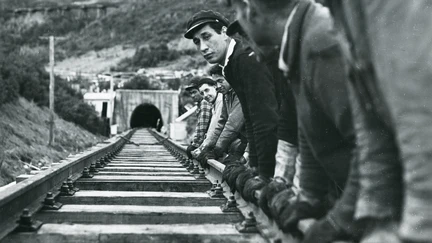
Photograph by R.A.O. Morgan for the New Zealand Railways Department.
The New Zealand Government's Railways Department (NZRW) was established in 1880 and looked after rail infrastructure and transport for over one hundred years before its corporatisation in 1982. As our population grew the original train routes in and out of Wellington were unable to cope with the demand; single-track systems weaving over slow terrain meant that services such as the Main Trunk Line through Johnsonville could neither be increased or sped up. Trains travelling over the Remutaka Range between Wellington and the Wairarapa were even fitted with brake "shoes" to control their speed on the harsh inclines, though these wore out so quickly they needed to be replaced after most trips.
In the 1930s serious consideration was placed on the efficiency and safety of the rail network, despite the challenges of an ongoing economic depression. While not all major projects could go ahead as planned (such as the abandoned Wainuiomata Tunnel), a new central railway station on Bunny Street opened in 1937 and provided a modern transport hub that stood out among the soot-covered buildings of industrial Pipitea.
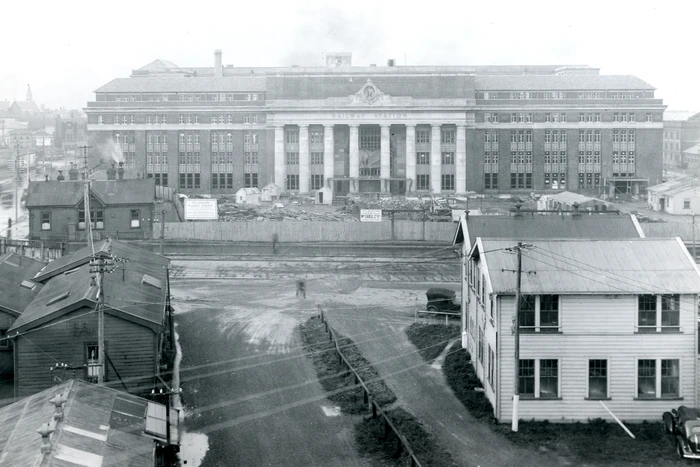
All photographs are from the New Zealand Railways Department. WCL reference 50010-562.
Wellington Railway Station shortly before construction was complete. Since-demolished wooden buildings line Bunny Street. c. 1936.
Our new train station was as grand as the Department was important; NZRW had provided an essential service in the growth of the country's economy, carrying both freight and passengers before the peak of commercialised air transport. In 1937 they oversaw a massive 21,000 staff members who were employed nationwide as drivers, engineers, mechanics, managers, and administrators.
The construction of the Tawa Deviation was another celebrated feat, creating what we now know as the 'Kapiti Line' which allowed for main trunk rail to bypass the difficult topography of Johnsonville and Khandallah. A year later the Johnsonville Branch Line was completely electrified and served by modern English Electric DM-class multiple units.
The Hutt Valley
Progress halted during the Second World War with railway workshops shifting their focus to manufacturing military supplies. Once the war was over, population growth coupled with urbanisation led to a housing crisis that put intense pressure on state housing. The Labour Government addressed this in Wellington in part by planning for new subdivisions on the mostly undeveloped eastern side of the Hutt River. The suburbs of Naenae and Taitā were born of this scheme and rapidly grew into communities in high need of transport connections.
Existing passenger trains ran from Wellington to Haywards (now Manor Park) via Melling, where much of the valley's population had initially been concentrated. The new housing developments on the other side of the river were an opportunity to modernise and add services and in the mid-1940s the Hutt Valley Branch saw its first extension to Naenae. Stations in Taitā were added a year later and subsequently linked to the existing Hutt Valley Line; the rail link between Melling and Haywards was then dismantled, leaving the Melling Branch as a separate service.
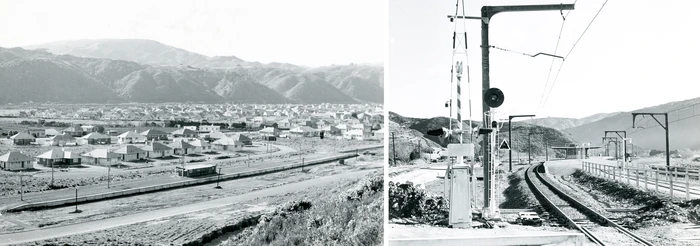
WCL references 50010-1549 and 50010-1303.
Left: the newly-built Wingate Station with state housing at Taitā in the background, 1950.
Right: a new double tracked level crossing at Silverstream, 1955.
While the Hutt Valley Line was being upgraded by NZRW the time had finally come to decommission the old Remutaka Fell Incline to the Wairarapa. It was decided to replace it with two tunnels - one at Maoribank and a much longer one below the Remutaka Range. Moving the railway from over the hill to under it would significantly reduce travel time and allow for more frequent services. Much of the project was handled by the Ministry of Works (MOW) who contracted out the labour to joint venture Morrison Knudsen Downer. This brought together overseas expertise and New Zealand labourers who would work from several sites.
Contracted work began in 1951 following preliminary works to survey and construct the two portals. Most of the workers involved were working in 8-hour excavation or concreting shifts, swapping out three times daily to ensure progress was constant. Additional staff were required to operate a power station, mechanics workshop and sawyer's shop, as well as fulfil some administrative duties.
Tunnelling was physically difficult and unaided by the dark and damp conditions. Due to the 'heavy' soil both full face and heading and bench methods were used; an unusual approach that could slow progress but would ensure structural integrity.
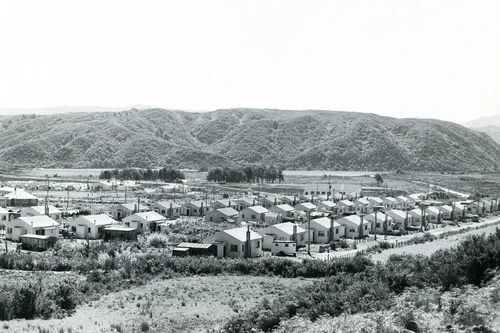
WCL reference 50010-1309.
The full extent of the Mangaroa camp.
To support the large crews who lived onsite, settlements were established at both sides of the hill with the western portal built at Mangaroa and the eastern portal near Featherston.
The larger of the two camps at Mangaroa (now Maymorn) featured rows of identical rail huts and cottages for staff. Single men were provided with a furnished 10 x 8 ft. hut with access to an ablutions block and kitchens. Meals were provided for by appointed chefs; no easy feat given that at any time there were around three hundred men employed for the project.
Larger homes were allocated to married men and their families and were used by New Zealand Railways staff in later stages of the project. Some of these railway cottages still remain in the Maymorn area as private properties.
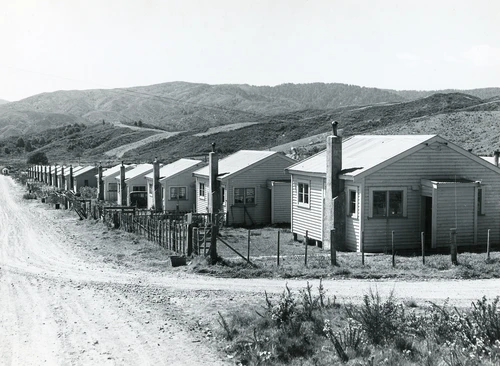
WCL reference 50010-1308.
Timber cottages for married men and their families at the Mangaroa camp, 1955.
At each end concrete crews followed behind the tunnellers, using over of 26 000 tonnes of cement to seal the interior. In April 1954, the two ends of the Remutaka Tunnel were finally connected, signalling the final stages of the Ministry of Works contract.
The New Zealand Railways Department took over the project in May 1955 to lay railway lines for the new Wellington to Wairarapa route. Rails were welded locally at the Woburn Railways workshop and then assembled with sleepers and fastenings at Mangaroa. The resulting 350 ft. tracks (approx. 106 metres long) were then transported into the tunnel as whole units to be laid end-to-end, eventually reaching the eastern portal near Featherston.
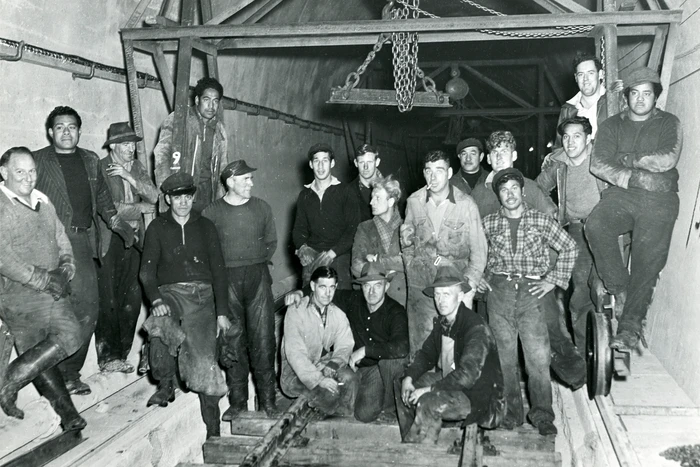
WCL reference 50010-1302.
New Zealand Railways staff standing below a rolling 'track hoist' used to position railway lines inside the Remutaka Tunnel.
The Remutaka Deviation officially opened on November 3rd, 1955, a little over four years since contracted work had begun. The original Fell Incline was now obsolete: the new route was safer, cheaper to run, and it reduced travel time between Featherston and Upper Hutt by 50 minutes.
No other major track layout changes in greater Wellington have occurred in the 70 years since; a range of factors led to Government-funded transport projects pivoting towards road infrastructure such as the Wellington Urban Motorway. The Ministry of Works and Development (as it was now called) was eventually dissolved in the 1980s. Similarly, the New Zealand Railways Department was corporatised in 1982 and its various services eventually became the responsibility of state-owned enterprises or were sold to private companies.
View our full New Zealand Railways photograph collection on Wellington City Recollect.